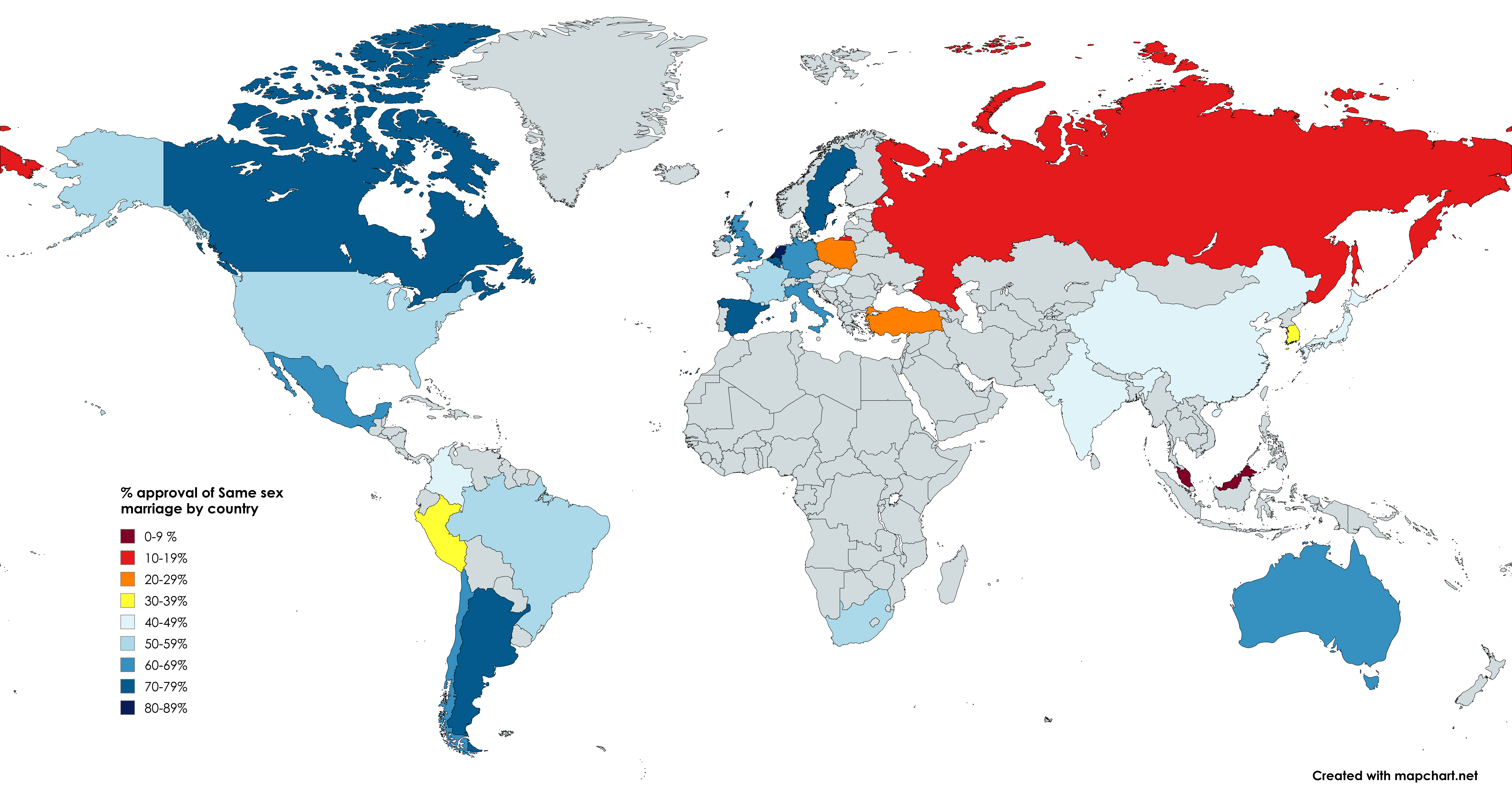Same Sex Marriage Approval Map by Country


Alex Cartwright
Senior Cartographer & GIS Specialist
Alex Cartwright is a renowned cartographer and geographic information systems specialist with over 15 years of experience in spatial analysis and data...
Geographic Analysis
What This Map Shows
This map visualizes the approval of same-sex marriage across select countries, highlighting the varying levels of acceptance and legal recognition of LGBTQ+ rights worldwide. Each country is color-coded to represent its stance on same-sex marriage, giving viewers a clear snapshot of where such unions are legally recognized and where they remain outlawed or unrecognized.
As we delve into the topic of same-sex marriage, it's essential to understand that this issue is not just a matter of legislation; it reflects broader societal attitudes and cultural values. The map serves as a powerful tool for illustrating these nuances, showing that acceptance of same-sex marriage often correlates with progressive social movements and changing public opinions.
Deep Dive into Same-Sex Marriage
The journey toward same-sex marriage legalization has been long and complex. Globally, the movement gained significant momentum in the early 2000s, with countries like the Netherlands leading the way in 2001 as the first to legalize same-sex marriage. Since then, numerous nations have followed suit, influenced by shifts in public opinion, advocacy from LGBTQ+ communities, and landmark court rulings.
Interestingly, research shows that acceptance of same-sex marriage tends to be higher among younger generations. According to various surveys, including the Ipsos Global Survey, there is a noticeable generational gap in attitudes toward LGBTQ+ rights. Younger individuals are generally more supportive of same-sex marriage compared to older populations, suggesting that as societal values evolve, so too does the legal landscape.
In countries where same-sex marriage is approved, it often signifies a broader recognition of LGBTQ+ rights. For instance, in nations like Canada, Spain, and Sweden, the legalization of same-sex marriage has been accompanied by other progressive reforms aimed at enhancing the rights of LGBTQ+ individuals, such as anti-discrimination laws and gender identity recognition.
However, the situation is starkly different in regions where same-sex marriage remains illegal. In many parts of Africa and the Middle East, strict laws against homosexuality persist, often rooted in cultural, religious, and historical contexts. Countries like Uganda and Saudi Arabia not only prohibit same-sex marriage but also impose severe penalties, including imprisonment and even the death penalty, for homosexual acts.
This disparity raises critical questions about human rights and the social fabric of various nations. As we analyze the map, it becomes evident that the acceptance of same-sex marriage is not merely a legal issue; it is intertwined with cultural identities, economic factors, and political climates that shape public attitudes.
Regional Analysis
The map clearly delineates regions of significant contrast in attitudes toward same-sex marriage. In North America, countries like the United States and Canada have seen a rapid increase in acceptance, with the U.S. Supreme Court legalizing same-sex marriage in 2015, reflecting a broader societal shift. In contrast, Central America remains largely conservative, with countries such as Guatemala and Honduras still resisting legal recognition.
Europe stands out as a leader in the acceptance of same-sex marriage, with many Western European nations, including France, Germany, and the UK, having embraced legal recognition. Interestingly, Eastern Europe presents a mixed picture; while countries like Malta have made significant strides, others, such as Poland and Hungary, show resistance, often influenced by nationalist movements and conservative ideologies.
In Asia, the landscape is varied. Countries like Taiwan made headlines in 2019 as the first in Asia to legalize same-sex marriage, while others remain deeply conservative. For example, in Japan, same-sex unions are not legally recognized, despite growing public support. The situation is similar in many South Asian countries, where cultural and religious factors heavily influence attitudes towards LGBTQ+ rights.
Significance and Impact
Understanding the approval of same-sex marriage is crucial for several reasons. First and foremost, it highlights the ongoing struggle for human rights and equality for LGBTQ+ individuals around the globe. The recognition of same-sex marriage often correlates with broader social acceptance and legal protections against discrimination.
Moreover, as societal attitudes evolve, the potential for change in legal frameworks increases. For instance, countries that have legalized same-sex marriage often witness a positive shift in public health, economic growth, and tourism, as they become more inclusive and appealing destinations for LGBTQ+ travelers.
Looking ahead, it's essential to monitor these trends. Will more countries follow the lead of progressive nations, or will resistance against LGBTQ+ rights continue to grow in the face of global advocacy? The map serves as a reminder of the diverse paths nations take in this ongoing journey toward equality, urging us to reflect on our values and the importance of inclusivity in societies worldwide.
Visualization Details
- Published
- August 12, 2025
- Views
- 284
Comments
Loading comments...